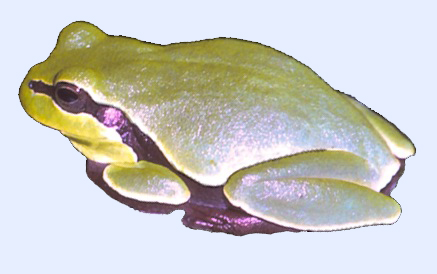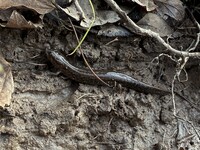Taxonomy
Class: AmphibiaOrder: CaudataFamily: PlethodontidaeSubfamily: PlethodontinaeAuthor: Pyron and Beamer, 2023
Taxonomic Comments: The Spotted Dusky Salamander (Desmognathus conanti ) and Northern Dusky Salamander (D. fuscus ) as traditionally recognized by herpetologists have a long and complex taxonomic history, with the former originally described as a subspecies of D. fuscus . It was treated as such until genetic studies revealed that it is not closely related to the latter (Beamer and Lamb 2008; Kozak et al. 2005). According to the latest systematic treatment of these species by Pyron and Beamer (2023a) At least 10 other currently recognized species of Desmognathus were either described from populations previously considered to be D. fuscus , described as or later considered to be subspecies of D. fuscus , or later considered to be synonyms of D. fuscus before ultimately being recognized as distinct species. The latest molecular analyses have also revealed extensive cryptic diversity within both D. conanti and D. fuscus as currently conceived, with these two species constituting a polyphyletic assemblages of 13 distinct mitochondrial lineages and perhaps as many as 11 candidate species. Pyron and Beamer (2023a) provide a very comprehensive review of the taxonomic history of this group. Desmognathus species and lineages. Gene exchange has occurred between both phylogenetically sister and geographically adjacent populations, as well as between distantly related and spatially separated groups. In summary, both D. conanti and D. fuscus are now each known to represent polyphyletic assemblages of multiple, geographically well-defined candidate species that are phylogenetically interdigitated with other recognized species. The candidate species include a “mountain dusky”phenotype with smaller, gracile bodies and round tails, a lowland “dusky” type with more robust, larger bodies and keeled tails, and a smaller lowland “dusky” form often associated with ravine streams and adjacent swamps, with slenderer bodies and less heavily-keeled tails.D. conanti and D. fuscus, the authors recognized six additional species based on genetic, geographic, and morphological evidence. They also redefined D. conanti and D. fuscus . The new species are D. anicetus , D. bairdi , D. campi , D. catahoula , D. lycos and D. tilleyi . Among the newly described species, all but D. catahoula occur in North Carolina. Species Comments:
Identification
Description: Desmognathus bairdi is generally similar to D. lycos , but is smaller and has a more slender build, with metamorphosed specimens varying from 24–55 mm SVL. The tail is triangular in cross-section on the distal half and has a well-developed keel. The toes lack dark, cornified tips as seen in some Desmognathus species. The dorsum has a distinct brownish to dull yellowish dorsal stripe with well-defined but somewhat irregular darker borders, and the lateral surfaces have indistinct darker mottling (Pyron and Beamer 2023a). The adults often have a row of light spots or portholes along the dorsolateral region and just below the dorsal stripe. The venter has clusters of yellowish and whitish flecks against a darker ground color that produces an overall finely reticulated or granular pattern.Desmognathus lycos is parapatric with D. bairdi at several localities in the central Piedmont. The latter species has a more slender or gracile body form relative to D. lycos . In addition, many adult specimens have a row of light-colored portholes on the dorsolateral surfaces that are not present on D. lycos . The site of collection is always useful in sorting these two species, with D. lycos in the western and central Piedmont and D. bairdi farther east. As of 2023, they have not been found to be syntopic at any site in North Carolina.Online Photos: Google iNaturalist AmphibiaWeb Account
Distribution in North Carolina
Distribution Comments: In North Carolina, this species is mostly found in the eastern Piedmont, with scattered populations also in the Coastal Plain (Pyron and Beamer, 2023a). Populations that have been identified genetically are also known from extreme north-central South Carolina (Chesterfield Co.), and just above the North Carolina-Virginia line in southeastern Virginia (Mecklenburg and Lunenburg Cos.). Desmognathus bairdi comes into close contact with D. lycos in most areas of its range (see distribution map above).Distribution Reference: Pyron and Beamer (2023a).County Map: Clicking on a county returns the records for the species in that county.
GBIF Global Distribution
Key Habitat Requirements
Habitat: This species is primarily restricted to streamside habitats where it uses rocks, logs, and leaf packs for cover. It is particularly abundant in ravine-type habitats in the Piedmont and Sandhills, but can also be found in swampier environments at some localities where it is parapatric with D. valtos (Pyron and Beamer, 2023a). Most aspects of the life history are undocumented. This species is closely related to D. lycos and presumably has a very similar life history.
Life History and Autecology
Terrestrial Life History: Spight's (1967) crudely estimated the density of salamanders in a spring-fed stream in Orange County to be 1.42 animals/m2 of habitat.
General Ecology
Adverse Environmental Impacts
Status in North Carolina
NHP State Rank: [S4]Global Rank: GNRStatus Comments: This newly described species is nearly endemic to North Carolina, with a few peripheral populations in nearby South Carolina and Virginia. Populations in North Carolina are widespread in the eastern Piedmont, with more scattered populations in the Coastal Plain. Local populations can reach high densities in high-quality streams with relatively protected watersheds, which are uncommon throughout its range. The majority of local populations have likely been impacted by watershed-level disturbances from urbanization, infrastructure development, agriculture and timbering, as has been documented for D. lycos that also occurs in the Piedmont (Willson and Dorcas, 2003; Price et al. 2006, 2010). Nonetheless, local populations still appear to be relatively common throughout the range.

 »
»


 »
»
